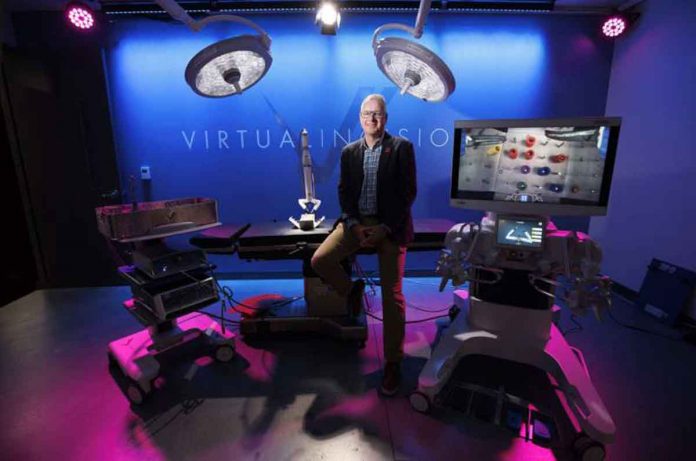Nebraska Engineering Professor Shane Farritor’s miniaturized robot may soon blast into space to put its abilities to the test.
NASA recently awarded the University of Nebraska-Lincoln $100,000 through the University of Nebraska Omaha’s Established Program to Stimulate Competitive Research (EPSCoR) to prepare the surgical robot for a test mission aboard the International Space Station in 2024.
“NASA has long been a supporter of this research, and as a result of that effort, our robot will have the opportunity to fly on the International Space Station,” Farritor said.
Farritor is a co-founder of Virtual Incision, a Nebraska Innovation Campus startup. He and his colleagues have been working on the tiny surgical robot known as MIRA, which stands for “miniaturized in vivo robotic assistant,” for nearly 20 years. Since its inception in 2006, the company has received more than $100 million in venture capital investment.
Over the next year, Farritor and engineering graduate student Rachael Wagner will write software, configure MIRA to fit inside a space station experiment locker, and thoroughly test the device to ensure that it is robust enough to survive launch and that its systems perform as expected in space. They will then have to wait about a year for the robot to take its turn aboard the station.
Wagner, from Lincoln, began working with Farritor as an undergraduate student and joined Virtual Incision after earning her bachelor’s degree in mechanical engineering in 2018. Later in 2022, a second graduate student may join the team.
MIRA has two significant advantages. First, it can be inserted through a small incision, allowing doctors to perform minimally invasive abdominal surgery. Surgeons have successfully used the device to perform colon resections in previous tests.
Second, the technology may someday allow surgeons to work remotely, such as repairing an astronaut’s ruptured appendix on a Mars mission or removing shrapnel from a soldier injured by an IED thousands of miles away. Previously, retired NASA astronaut Clayton Anderson took control of MIRA while at the Johnson Space Center in Houston, directing it to perform surgery-like tasks in an operating room 900 miles away at the University of Nebraska Medical Center in Omaha.
MIRA will operate autonomously aboard the space station, without the guidance of a doctor or an astronaut. It will cut tautly stretched rubber bands and push metal rings along a wire inside a microwave oven-sized experiment locker, mimicking surgical gestures.
“These simulations are critical because of the amount of data we will collect during the tests,” Wagner explained.
It will be the robot’s most autonomous operation to date. Although Farritor expects MIRA to be self-sufficient in 50 to 100 years, the goal of this mission is to fine-tune the robot’s operation in zero gravity.
The device is designed to operate autonomously in order to conserve space station communications bandwidth and reduce the amount of time astronauts spend with the experiment.
“The astronaut flips a switch, the process begins, and the robot completes its work on its own,” Farritor explained. “It’s done two hours later when the astronaut switches it off.”
Farritor, the David and Nancy Lederer Professor of Engineering, is the chief technology officer of Virtual Incision, which he co-founded with Dmitry Oleynikov, a former University of Nebraska Medical Center professor of surgery. Farritor was named the first recipient of the University of Nebraska system’s intellectual property award, the Faculty IP Innovation and Commercialization Award, in April 2022.
Farritor’s robotics research has been supported by NASA and the US Army.
“As people travel deeper and deeper into space, they may need to perform surgery someday,” Farritor speculated. “We’re working towards it.”

